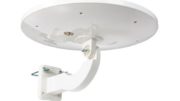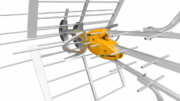Dear readers, it’s interesting to me that I’m just now getting around to writing this article. Why? Because it was, perhaps, one of the first tech questions I was asked in my lifetime. I believe the first time someone told me they wanted a wireless TV antenna was about 1984. For it to have taken nearly forty years to document the answer does seem weird, doesn’t it? So let’s jump in.
The “wireless over-the-air antenna” that everyone wants
Here’s what people really want. They want to put an antenna up on their roof and magically, perhaps through the use of a smaller antenna on their TVs, receive a signal. In this perfect scenario, there would be no wires at all. This isn’t going to happen and there are several reasons why.
1. You need power and power needs wires
In the theoretical example above, there are no wires at all and yet there’s transmission of some sort. But, transmission needs power. I suppose in an absurd scenario you could pair the antenna with solar panels or something, but that takes this even further away from the real world than it already is. One way or another, you would need power. That would mean running a wire up to the antenna to power it.
2. You can’t rebroadcast over the regular TV frequencies
If you don’t have a license to broadcast on the frequencies used for over-the-air TV, it’s illegal to do it. And, this is not a simple license to get. It takes a lot of money and a lot of time. All of that is on purpose. No one wants regular folks to be able to broadcast on TV frequencies because that would be a real mess. Nothing would ever get through.
Yes, there are frequencies that regular folks can broadcast on. For example, consider Wi-Fi and cell phones. Both of these are designed so that there is minimal interference and a lot of traffic can coexist without causing a problem. The devices themselves are licensed and so regular folks don’t need to go through the licensing process themselves. Over-the-air TV isn’t like that.
3. Demand is too low for this to really get developed.
People generally aren’t aware of how much things cost to engineer. The actual manufacturing cost of something could be really small, thanks to large-scale overseas facilities. But, manufacturing, testing, and making sure the thing works at all cost a lot of money. The development money needs to be factored into the price of the final piece.
Think about it this way. If it cost $1,000,000 to design something, and you only expect to sell 10,000 of them, you need to build $100 profit into the thing so the cost of development is paid back. And, because of distribution costs, the consumer’s price is double or triple the cost straight from the manufacturer. In this example, let’s say the cost to manufacture is about $5. Add in development costs and distribution costs, and the cost to the consumer, just to allow the manufacturer to break even, is $210 or higher.
I’m bringing this up because conventional wisdom tells us that there aren’t really too many people who want a wireless TV antenna, so the cost of each would be really high.
The options that actually are available
If you don’t want to wire your TV antenna to each TV, there are some options. It’s up to you which one works for you, although I think there’s a clear winner here.
1. Wireless HDMI
There are a number of systems that let you broadcast HDMI wirelessly. This is one of the more popular ones. In this scenario you would connect a TV tuner to the antenna, then rebroadcast its HDMI output. This is an elegant solution but the cost is very high and it’s not really scalable to multiple TVs.
2. AirTV Anywhere
A better option is something like DISH’s AirTV Anywhere box. Connect this to an antenna and it will allow you to stream your local channels anywhere in the world, whether it’s to your back bedroom or to Boston’s Back Bay. It connects to your home Wi-Fi and then you use the free Sling app on a streaming box to get those local channels. It’s not necessary to have the paid Sling service in order to make this work, but it is the same app.
As an added benefit, you get a 1TB DVR to record those local channels. That gives you even more flexibility. You can even watch on four devices at the same time.
Choosing the best option for you
I personally think the AirTV Anywhere is the more elegant and simple option. It’s also the less expensive option. However, if you have other ideas on how to distribute over-the-air signals legally, I’d like to hear them. Leave a comment below, or if you think it can be done with parts available at SolidSignal.com, call the experts! We’re here for you at 888-233-7563 or fill out the form below.





